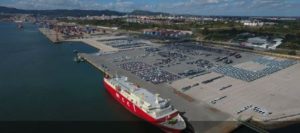 Felicity Landon finds that deeper water and new rail links are set to boost the Portuguese port.
Felicity Landon finds that deeper water and new rail links are set to boost the Portuguese port.
Deeper water, digital advances and the completion of a new 94-kilometre rail line will reinforce the position of Setúbal as a key Iberian shortsea port and one of the most competitive ports on Europe’s Atlantic Coast, its operators believe.
Setúbal is only 45 kilometres from Lisbon and in one of Portugal’s most important industrial areas – and, with land available for port and industry expansion and strong backing from the government’s 2026 Horizon strategic programme for port growth, confidence is high.
Last year the port handled about 6.6m tonnes, including 224,000 vehicles on its ro-ro services and 152,000 teu in containers. The main exports, making up 59% of the total throughput, are cement, paper and vehicles – in 2017, total exports included 2.3m tonnes to Europe and 1.3m tonnes to Africa.
This year the port is forecasting container growth, on existing and new services, but ro-ro is the real star. “The growth of production and the increase of exports may turn this year into the best one ever in vehicle handling at the Port of Setúbal,” says a spokesperson. In the first quarter, the port handled more than 75,000 vehicles, an increase of more than 38% on the same period in 2017, while containers rose by 2.8%.
The port has specialised port terminals handling several types of cargo – all outside the city, with direct links to national and international road and rail links that form part of Europe’s TEN-T Atlantic Corridor.
The 2026 Horizon project has invested in innovation and modernisation for ports, including the PSW II (Port Single Window) and the single port invoice (FUP), as well as moving forward with a Logistic Single Window (LSW) project to bring road transport, dry ports and other supply chain operators into the PSW.
Meanwhile, to allow the handling of larger vessels, the port’s Maritime Port Access Improvement Project is due for completion by the end of this year. “This is essential to the Port of Setúbal and consists of deepening the entrance and north channel to 15 metres and 13.5 metres, allowing the reception of vessels up to 3,000 teu-4,000 teu, as well as the Rail Accesses Improvement Project, in the technical study stage, which will allow more direct and efficient connections, favouring exports,” says the spokesperson. The port’s location on the north-south and east-west maritime routes also distinguishes Setúbal from others, she adds.
Hinterland connections
Industry is on the doorstep – including a 400-hectare industrial park. The port’s catchment area takes in the vehicle production operations of Volkswagen AutoEuropa and Faurecia, the Megasa steel company, Navigator papermill, the GE factory and Sapec chemical and fertiliser production.
Setúbal’s connections will be significantly improved by the completion of the Évora-Elvas-Caia railway; work on the 94 kilometre €500m ‘missing link’ between the Portuguese interior and Spain is expected to start in March 2019, for completion in 2022.
The launch of a public tender for the track construction has been welcomed by Fernando Fernandes, project lead of the Blue Atlantic Industrial and Logistics Park project at Setúbal.
The rail project will transform Portuguese maritime trade and export, he says, creating a new international trade corridor connecting Portugal to the rest of Europe by providing faster, easier and better access from key ports such as Setúbal and Sines. This will greatly improve conditions for investment, internationalism and exports, he says.
Blue Atlantic, a 96-hectare site in the Metrena Industrial Zone at Setúbal, is being offered for sale by Sapec. It is being primed for maritime, ports and logistics investors – in January, it released plans for an 800 metre quay to berth two panamax vessels.
“Blue Atlantic is a very large, empty plot of land with huge potential,” says Mr Fernandes. “It has all the ingredients for a developer to create a world-class multimodal export hub or industrial and logistics park.”
He has also welcomed the dredging project at the port, which he says will unleash trade and export opportunities.
“The Port of Setúbal is already at a large advantage due to its prime position on the Atlantic, along global shipping routes,” he says. “A major benefit is that vessels can avoid the congested Mediterranean passage. The fact that the facility will be able to accommodate larger vessels than ever before is a transformational move for transport and logistics firms, exporters and traders in our region.”
source: Portstrategy